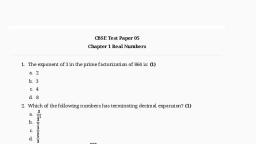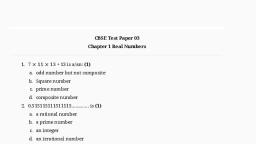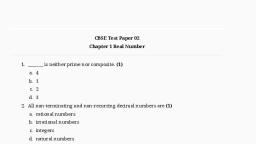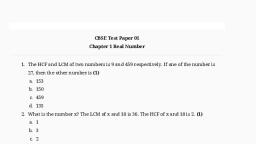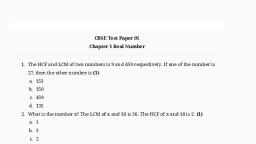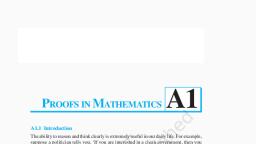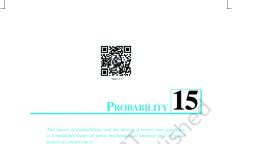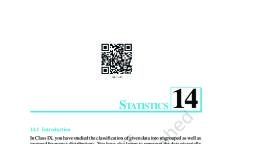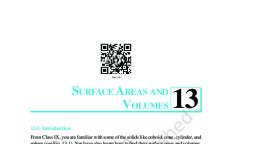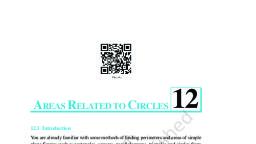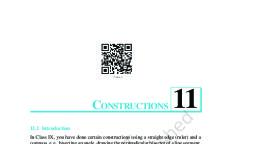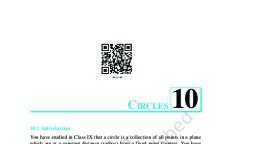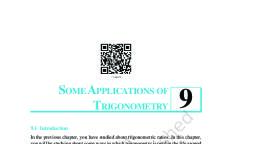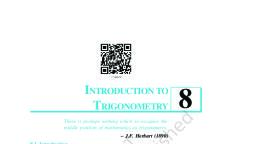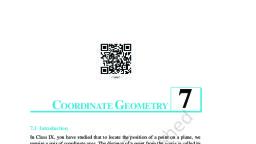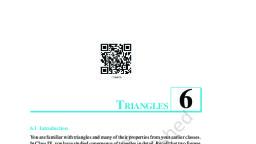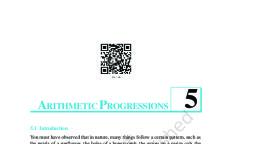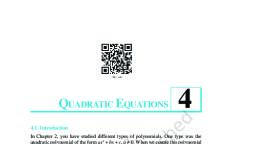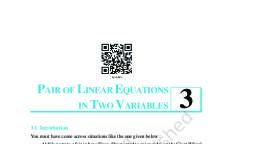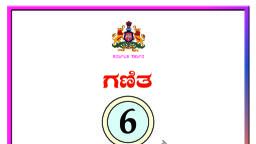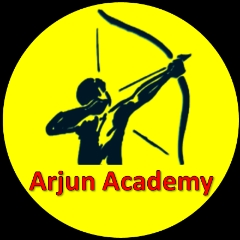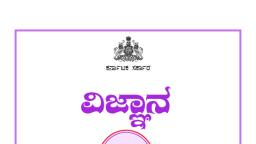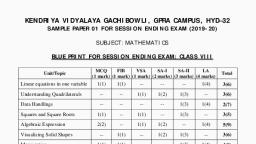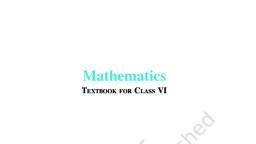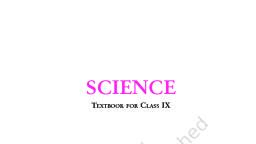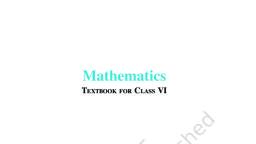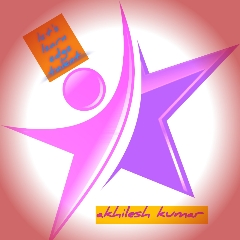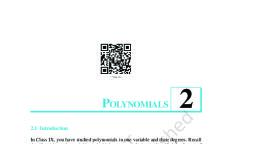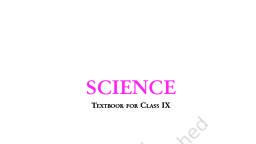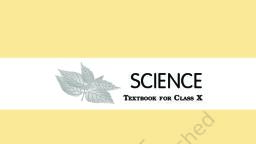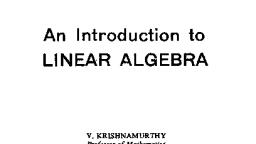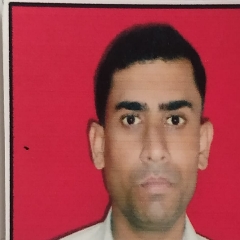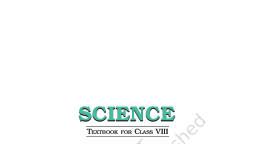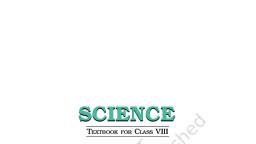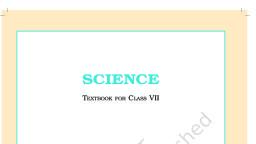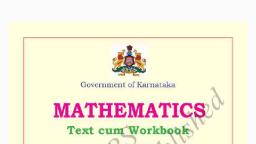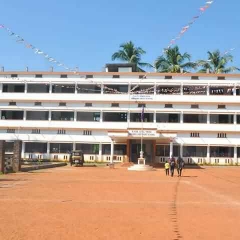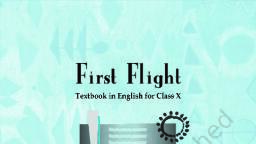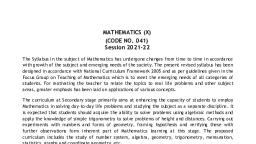Page 1 :
MATHEMATICS, Textbook for Class X, , 2021–22
Page 2 :
1062 – MATHEMATICS, , ISBN 81-7450-634-9, , Textbook for Class X, First Edition, December 2006 Pausa 1928, Reprinted, October 2007, January 2009, December 2009, November 2010, January 2012, November 2012, November 2013, November 2014, December 2015, December 2016, December 2017, January 2019, August 2019, January 2021, , Kartika 1929, Pausa 1930, Agrahayana 1931, Kartika 1932, Pausa 1933, Kartika 1934, Kartika 1935, Agrahayana 1936, Agrahayana 1937, Pausa 1938, Pausa 1939, Pausa 1940, Shravana 1941, Pausa 1942, , ALL RIGHTS RESERVED, q, , No part of this publication may be reproduced, stored in a retrieval system or, transmitted, in any form or by any means, electronic, mechanical, photocopying,, recording or otherwise without the prior permission of the publisher., , q, , This book is sold subject to the condition that it shall not, by way of trade, be, lent, re-sold, hired out or otherwise disposed of without the publisher’s, consent, in any form of binding or cover other than that in which it is published., , q, , The correct price of this publication is the price printed on this page, Any, revised price indicated by a rubber stamp or by a sticker or by any other means, is incorrect and should be unacceptable., OFFICES OF THE PUBLICATION DIVISION, NCERT, NCERT Campus, Sri Aurobindo Marg, New Delhi 110 016, , Phone : 011-26562708, , 108, 100 Feet Road, Hosdakere Halli Extension, Banashankari III Stage, Bengaluru 560 085, , Phone : 080-26725740, , PD 285T RSP, , Navjivan Trust Building, P.O.Navjivan, Ahmedabad 380 014, , Phone : 079-27541446, , © National Council of Educational, Research and Training, 2006, , CWC Campus, Opp. Dhankal Bus Stop, Panihati, Kolkata 700 114, , Phone : 033-25530454, , CWC Complex, Maligaon, Guwahati 781 021, , Phone : 0361-2674869, , Publication Team, , ` 160.00, , Printed on 80 GSM paper with, NCERT watermark, Published at the Publication Division by, the Secretary, National Council of, Educational Research and Training,, Sri Aurobindo Marg, New Delhi 110 016, and printed at Nova Publications, & Printers Pvt. Ltd., Plot No. 9-10,, Sector -59, Phase-II, Faridabad,, Pincode - 121 004 (Haryana), , Head, Publication, Division, , : Anup Kumar Rajput, , Chief Editor, , : Shveta Uppal, , Chief Production, Officer, , : Arun Chitkara, , Chief Business, : Vipin Dewan, Manager (In charge), Editor, , : Bijnan Sutar, , Production Assistant : Sunil Kumar, , Illustrations, Joel Gill and Arvinder Chawla, Cover, Arvinder Chawla, , 2021–22
Page 3 :
Foreword, The National Curriculum Framework, 2005, recommends that children’s life at school, must be linked to their life outside the school. This principle marks a departure from, the legacy of bookish learning which continues to shape our system and causes a, gap between the school, home and community. The syllabi and textbooks developed, on the basis of NCF signify an attempt to implement this basic idea. They also, attempt to discourage rote learning and the maintenance of sharp boundaries between, different subject areas. We hope these measures will take us significantly further in, the direction of a child-centred system of education outlined in the National Policy, on Education (1986)., The success of this effort depends on the steps that school principals and teachers, will take to encourage children to reflect on their own learning and to pursue, imaginative activities and questions. We must recognise that, given space, time and, freedom, children generate new knowledge by engaging with the information passed, on to them by adults. Treating the prescribed textbook as the sole basis of examination, is one of the key reasons why other resources and sites of learning are ignored., Inculcating creativity and initiative is possible if we perceive and treat children as, participants in learning, not as receivers of a fixed body of knowledge., These aims imply considerable change in school routines and mode of functioning., Flexibility in the daily time-table is as necessary as rigour in implementing the annual, calendar so that the required number of teaching days are actually devoted to teaching., The methods used for teaching and evaluation will also determine how effective this, textbook proves for making children’s life at school a happy experience, rather than, a source of stress or boredom. Syllabus designers have tried to address the problem, of curricular burden by restructuring and reorienting knowledge at different stages, with greater consideration for child psychology and the time available for teaching., The textbook attempts to enhance this endeavour by giving higher priority and space, to opportunities for contemplation and wondering, discussion in small groups, and, activities requiring hands-on experience., The National Council of Educational Research and Training (NCERT) appreciates, the hard work done by the textbook development committee responsible for this, book. We wish to thank the Chairperson of the advisory group in Science and, Mathematics, Professor J.V. Narlikar and the Chief Advisors for this book, Professor, P. Sinclair of IGNOU, New Delhi and Professor G.P. Dikshit (Retd.) of Lucknow, University, Lucknow for guiding the work of this committee. Several teachers, , 2021–22
Page 4 :
iv, , contributed to the development of this textbook; we are grateful to their principals, for making this possible. We are indebted to the institutions and organisations which, have generously permitted us to draw upon their resources, material and personnel., We are especially grateful to the members of the National Monitoring Committee,, appointed by the Department of Secondary and Higher Education, Ministry of Human, Resource Development under the Chairpersonship of Professor Mrinal Miri and, Professor G.P. Deshpande, for their valuable time and contribution. As an organisation, committed to systemic reform and continuous improvement in the quality of its, products, NCERT welcomes comments and suggestions which will enable us to, undertake further revision and refinement., Director, National Council of Educational, Research and Training, , New Delhi, 15 November 2006, , 2021–22
Page 5 :
Preface, Through the years, from the time of the Kothari Commission, there have been, several committees looking at ways of making the school curriculum meaningful, and enjoyable for the learners. Based on the understanding developed over the, years, a National Curriculum Framework (NCF) was finalised in 2005. As part of, this exercise, a National Focus Group on Teaching of Mathematics was formed. Its, report, which came in 2005, highlighted a constructivist approach to the teaching, and learning of mathematics., The essence of this approach is that children already know, and do some, mathematics very naturally in their surroundings, before they even join school. The, syllabus, teaching approach, textbooks etc., should build on this knowledge in a way, that allows children to enjoy mathematics, and to realise that mathematics is more, about a way of reasoning than about mechanically applying formulae and algorithms., The students and teachers need to perceive mathematics as something natural and, linked to the world around us. While teaching mathematics, the focus should be on, helping children to develop the ability to particularise and generalise, to solve and, pose meaningful problems, to look for patterns and relationships, and to apply the, logical thinking behind mathematical proof. And, all this in an environment that the, children relate to, without overloading them., This is the philosophy with which the mathematics syllabus from Class I to, Class XII was developed, and which the textbook development committee has tried, to realise in the present textbook. More specifically, while creating the textbook, the, following broad guidelines have been kept in mind., l, l, l, l, , l, , The matter needs to be linked to what the child has studied before, and to, her experiences., The language used in the book, including that for ‘word problems’, must be, clear, simple and unambiguous., Concepts/processes should be introduced through situations from the, children’s environment., For each concept/process give several examples and exercises, but not of, the same kind. This ensures that the children use the concept/process again, and again, but in varying contexts. Here ‘several’ should be within reason,, not overloading the child., Encourage the children to see, and come out with, diverse solutions to, problems., , 2021–22
Page 6 :
vi, l, l, , l, l, l, , l, l, l, l, , As far as possible, give the children motivation for results used., All proofs need to be given in a non-didactic manner, allowing the learner to, see the flow of reason. The focus should be on proofs where a short and, clear argument reinforces mathematical thinking and reasoning., Whenever possible, more than one proof is to be given., Proofs and solutions need to be used as vehicles for helping the learner, develop a clear and logical way of expressing her arguments., All geometric constructions should be accompanied by an analysis of the, construction and a proof for the steps taken to do the required construction., Accordingly, the children would be trained to do the same while doing, constructions., Add such small anecdotes, pictures, cartoons and historical remarks at, several places which the children would find interesting., Include optional exercises for the more interested learners. These would, not be tested in the examinations., Give answers to all exercises, and solutions/hints for those that the children, may require., Whenever possible, propagate constitutional values., , As you will see while studying this textbook, these points have been kept in mind, by the Textbook Development Committee. The book has particularly been created, with the view to giving children space to explore mathematics and develop the abilities, to reason mathematically. Further, two special appendices have been given — Proofs, in Mathematics, and Mathematical Modelling. These are placed in the book for, interested students to study, and are only optional reading at present. These topics, may be considered for inclusion in the main syllabi in due course of time., As in the past, this textbook is also a team effort. However, what is unusual, about the team this time is that teachers from different kinds of schools have been, an integral part at each stage of the development. We are also assuming that teachers, will contribute continuously to the process in the classroom by formulating examples, and exercises contextually suited to the children in their particular classrooms. Finally,, we hope that teachers and learners would send comments for improving the textbook, to the NCERT., PARVIN SINCLAIR, G.P. DIKSHIT, Chief Advisors, Textbook Development Committee, , 2021–22
Page 9 :
Contents, Foreword, 1., , 2., , 3., , Preface, , v, , Real Numbers, , 1, , 1.1, , Introduction, , 1, , 1.2, , Euclid’s Division Lemma, , 2, , 1.3, , The Fundamental Theorem of Arithmetic, , 7, , 1.4, , Revisiting Irrational Numbers, , 11, , 1.5, , Revisiting Rational Numbers and Their Decimal Expansions, , 15, , 1.6, , Summary, , 18, , Polynomials, , 20, , 2.1, , Introduction, , 20, , 2.2, , Geometrical Meaning of the Zeroes of a Polynomial, , 21, , 2.3, , Relationship between Zeroes and Coefficients of a Polynomial, , 28, , 2.4, , Division Algorithm for Polynomials, , 33, , 2.5, , Summary, , 37, , Pair of Linear Equations in Two Variables, , 38, , 3.1, 3.2, 3.3, 3.4, , 38, 39, 44, 50, 50, 54, 57, 63, 69, , 3.5, 3.6, 4., , iii, , Introduction, Pair of Linear Equations in Two Variables, Graphical Method of Solution of a Pair of Linear Equations, Algebraic Methods of Solving a Pair of Linear Equations, 3.4.1 Substitution Method, 3.4.2 Elimination Method, 3.4.3 Cross-Multiplication Method, Equations Reducible to a Pair of Linear Equations in Two Variables, Summary, , Quadratic Equations, , 70, , 4.1, , Introduction, , 70, , 4.2, , Quadratic Equations, , 71, , 2021–22
Page 10 :
x, , 5., , 6., , 7., , 8., , 4.3, , Solution of a Quadratic Equation by Factorisation, , 74, , 4.4, , Solution of a Quadratic Equation by Completing the Square, , 76, , 4.5, , Nature of Roots, , 88, , 4.6, , Summary, , 91, , Arithmetic Progressions, , 93, , 5.1, , Introduction, , 93, , 5.2, , Arithmetic Progressions, , 95, , 5.3, , nth Term of an AP, , 100, , 5.4, , Sum of First n Terms of an AP, , 107, , 5.5, , Summary, , 116, , Triangles, , 117, , 6.1, , Introduction, , 117, , 6.2, , Similar Figures, , 118, , 6.3, , Similarity of Triangles, , 123, , 6.4, , Criteria for Similarity of Triangles, , 129, , 6.5, , Areas of Similar Triangles, , 141, , 6.6, , Pythagoras Theorem, , 144, , 6.7, , Summary, , 154, , Coordinate Geometry, , 155, , 7.1, , Introduction, , 155, , 7.2, , Distance Formula, , 156, , 7.3, , Section Formula, , 162, , 7.4, , Area of a Triangle, , 168, , 7.5, , Summary, , 172, , Introduction to Trigonometry, , 173, , 8.1, , Introduction, , 173, , 8.2, , Trigonometric Ratios, , 174, , 8.3, , Trigonometric Ratios of Some Specific Angles, , 181, , 8.4, , Trigonometric Ratios of Complementary Angles, , 187, , 8.5, , Trigonometric Identities, , 190, , 8.6, , Summary, , 194, , 2021–22
Page 11 :
xi, , 9., , Some Applications of Trigonometry, , 195, , 9.1, , Introduction, , 195, , 9.2, , Heights and Distances, , 196, , 9.3, , Summary, , 205, , 10. Circles, , 206, , 10.1 Introduction, , 206, , 10.2 Tangent to a Circle, , 207, , 10.3 Number of Tangents from a Point on a Circle, , 209, , 10.4 Summary, , 215, , 11. Constructions, , 216, , 11.1 Introduction, , 216, , 11.2 Division of a Line Segment, , 216, , 11.3 Construction of Tangents to a Circle, , 220, , 11.4 Summary, , 222, , 12. Areas Related to Circles, , 223, , 12.1 Introduction, , 223, , 12.2 Perimeter and Area of a Circle — A Review, , 224, , 12.3 Areas of Sector and Segment of a Circle, , 226, , 12.4 Areas of Combinations of Plane Figures, , 231, , 12.5 Summary, , 238, , 13. Surface Areas and Volumes, , 239, , 13.1 Introduction, , 239, , 13.2 Surface Area of a Combination of Solids, , 240, , 13.3 Volume of a Combination of Solids, , 245, , 13.4 Conversion of Solid from One Shape to Another, , 248, , 13.5 Frustum of a Cone, , 252, , 13.6 Summary, , 258, , 14. Statistics, , 260, , 14.1 Introduction, , 260, , 14.2 Mean of Grouped Data, , 260, , 14.3 Mode of Grouped Data, , 272, , 2021–22
Page 12 :
xii, , 14.4 Median of Grouped Data, , 277, , 14.5 Graphical Representation of Cumulative Frequency Distribution, , 289, , 14.6 Summary, , 293, , 15. Probability, , 295, , 15.1 Introduction, , 295, , 15.2 Probability — A Theoretical Approach, , 296, , 15.3 Summary, , 312, , Appendix A1 : Proofs in Mathematics, , 313, , A1.1 Introduction, , 313, , A1.2 Mathematical Statements Revisited, , 313, , A1.3 Deductive Reasoning, , 316, , A1.4 Conjectures, Theorems, Proofs and Mathematical Reasoning, , 318, , A1.5 Negation of a Statement, , 323, , A1.6 Converse of a Statement, , 326, , A1.7 Proof by Contradiction, , 329, , A1.8 Summary, , 333, , Appendix A2 : Mathematical Modelling, , 334, , A2.1 Introduction, , 334, , A2.2 Stages in Mathematical Modelling, , 335, , A2.3 Some Illustrations, , 339, , A2.4 Why is Mathematical Modelling Important?, , 343, , A2.5 Summary, , 344, , Answers/Hints, , 345, , 2021–22

